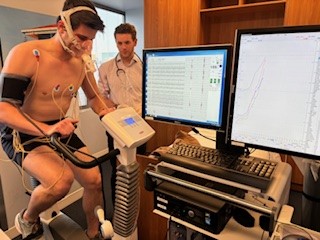
25 Jun Cardiopulmonary Exercise Testing (CPET)
Posted at 04:58h
in Uncategorized
A cardiopulmonary exercise test is considered a non-invasive procedure to assess cardiac and respiratory function.
Why perform a CPET:
- Investigation of unexplained dyspnoea.
- Evaluation of cardiovascular disease.
- Evaluation of respiratory disease.
- Preoperative assessment for major surgery.
- Exercise prescription.
- Evaluation of impairment/disability.
- Evaluation of exercise tolerance.
With a low complication rate:
- Incidence of a complication requiring hospitalisation of ≤2 in 1000.
- Incidence of a major cardiac event of 1.2 per 10 000.
- Incidence of mortality of 2–5 per 100 000.
Test preparation:
- Refrain from exercise on the day of the test and be well rested.
- Eat a light meal or breakfast no less than 2 hours previously.
- Maintain hydration by drinking water.
- Avoid caffeine and alcohol prior to the test.
- Take all routine/normal medication and bring along a medication list.
- Bring along all rescue medications, for example, inhalers or nitrolingual sprays.
- Wear light comfortable clothing and shoes suitable to exercise in.
- Avoid use of body lotion on the upper body, as this may affect ECG electrode placement.
- Abstain from smoking for at least 8 hours prior to the test.
- Refrain from wearing any nail varnish or false nails.
What does the test involve:
- Resting objective measures
- ECG
- Blood pressure
- SpO2
- Exercise Component (bike)
- Warm up phase
- Exercise phase
- Recovery phase
- Return to baseline measures
Points to note:
- Please bring with you any relevant medical history or have this provided on the initial referral.
- A current medication list should also be brought along.
- This is important as the test can be terminated early if certain events arise, these include but not limited to
- Angina:
- Symptomatic: >2 mm ST depression.
- Asymptomatic: 3 mm ST depression.
- >1 mm ST elevation.
- Significant arrhythmias causing symptoms or haemodynamic compromise
- Fall in systolic blood pressure >20 mm Hg from the highest value during the test
- Hypertension >250 mm Hg systolic and >120 mm Hg diastolic
- Patients with abdominal aortic aneurysms undergoing preoperative assessment >200 mm Hg systolic or >110 mm Hg diastolic.
- Severe desaturation: SpO2<80% (lower may be accepted in patients with known underlying lung disease or congenital heart disease if agreed with referring clinician).
- Loss of coordination.
- Mental confusion.
- Dizziness or faintness.
- However, a patient will commonly report
- Dyspnoea (shortness of breath)
- Leg fatigue.
- Chest pain.
- Pain/physical discomfort.
- Dizziness
- Saddle discomfort.
- Palpitations.
At the Wesley Lung Function Lab a physician, nursing and scientific staff are present whilst performing a CPET.
For more information on CPET testing visit:

